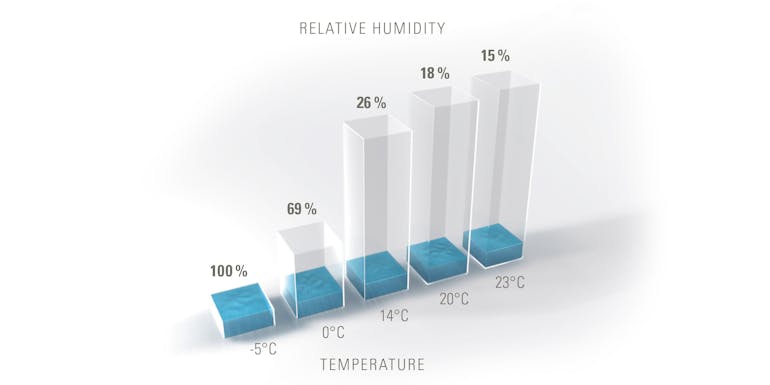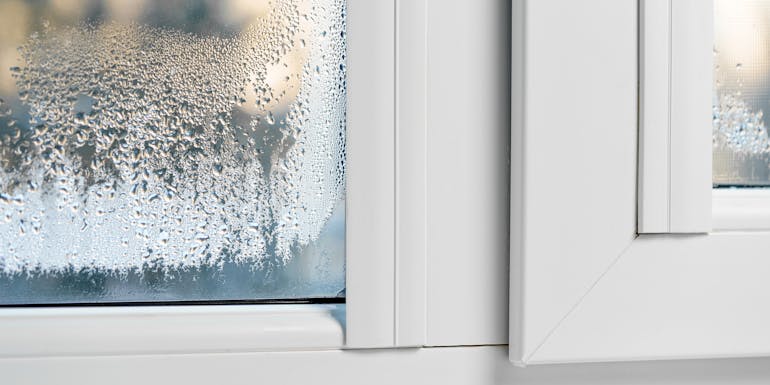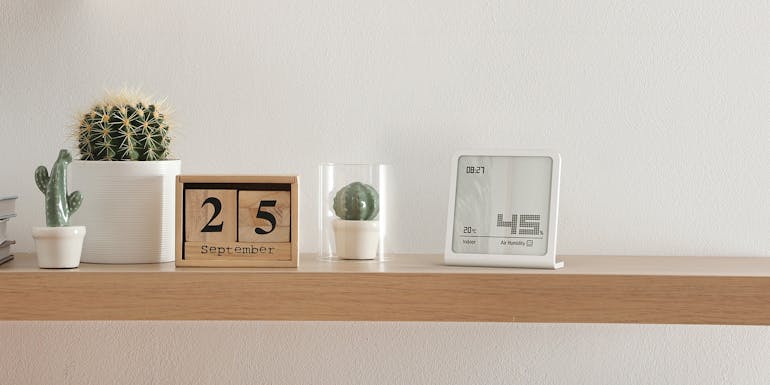
Monika Hofstetter , 13 June 2022
Measure humidity
Absolute and relative humidity
Sooner or later, anyone wanting to improve the climate indoors and their own well-being will need to address the subject of humidity – because it’s important to know the level of humidity in a room. Basically, we talk about absolute and relative humidity: but what do these terms mean and what is the difference between them? What is the optimal humidity indoors and what happens if that level is not achieved?
The air indoors contains finely dispersed water vapour resulting from water evaporating from the atmosphere on the one hand and from breathing, plants, cooking and showers on the other hand. Usually invisible, this water vapour contains tiny droplets and is known as humidity. The amount of moisture that the air can absorb will depend on the temperature: the warmer the air, the more water it can absorb. The point at which the air is unable to absorb any more humidity is known as saturation point. When that point is reached, condensation forms.
What is relative humidity?
Why should we measure humidity? Because it is very important for our own well-being as well as for animals and plants. Relative humidity also plays a significant role for buildings, wooden furniture and musical instruments. The best-known and most frequently used unit of measurement is relative humidity which describes the percentage of water vapour in the air at a certain temperature.
The graph shows that while the quantity of water in the air stays the same, the relative humidity can vary depending on the temperature in the room. If you put the heating on, for example, the quantity of water in a room will remain the same but due to the increase in temperature, the relative humidity in the room will drop. Let us take the example from the graph as an illustration: At 14 °C, the relative humidity is 26 per cent. If the room is now heated to 20 °C, the humidity will drop to 18 per cent even though the effective quantity of water in the air remains constant.
And what is absolute humidity?
Absolute humidity describes the effective quantity of water vapour in the air. The actual quantity of water vapour present in the indoor air at the time of observation is displayed in grams. So one difference between absolute and relative humidity lies in the type of measurand (grams and per cent). Both quantity indications are used for different purposes and provide different information. Relative humidity is one of the main parameters for private use. At home, the indoor climate is usually checked using a hygrometer. A relative humidity level of between 40 and 60 per cent is deemed optimal.
Overly damp indoor air and consequences such as mould
If the value displayed by your device for measuring humidity is more than 60 per cent, this could lead to the development of mould in the long run. Among other things, mould can cause respiratory problems, eczema or allergies. Also, if the indoor air is too damp, it can provide the ideal environment for house mites. If the relative humidity is too high, it can also lead to sleep problems and is particularly unpleasant on hot days when the air indoors becomes stuffy. It is therefore recommended for the humidity indoors to be constantly kept below 60 per cent. A dehumidifier is an ideal way to combat indoor air that is overly damp as it will prevent mould, mites and other problems and improve the indoor climate. Incidentally, spaces such as garages and basements in particular are often affected by indoor air that is too damp.
What happens if the air indoors is too dry?
If the relative humidity indoors is constantly below 40 per cent, the level of humidity is too low. This can affect our well-being as dry indoor air can lead to sleep problems and snoring. Our airways and eyes can also suffer since there is insufficient moisture for our mucous membranes. If the level of humidity is too low, our skin will tighten and become flaky.
When the humidity is too low, flu viruses survive longer, and the risk of infections increases. In addition, over a long period of time a low level of humidity is bad for musical instruments, wooden furniture, paintings, and parquet floors. Wooden items can become damaged as a result of warping. How can you improve the indoor climate in such cases? By using a humidifier, for example.
40–60% is the optimal level for humidity indoors
Often, we may not realise that the level of humidity is less than optimal, and it can be a while before we notice the effects of humidity that is too high or too low. The constant measurement of relative humidity is therefore highly recommended. Ideally, you should place hygrometers in your main rooms so that you can take measures early enough to improve the indoor climate. Watch this video to find out more on the subject of devices for measuring humidity.



















